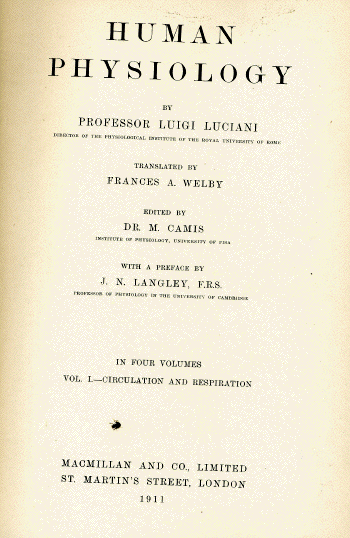-
-
- XIV. The rhythmical respiratory movements
suffer various moifications, in abnormal or
unusual conditions, or to satisfy various
temporary needs or occurrences, or, lastly, as
the motor expression of special sentiments of
pleasure or pain, fatigue, ennui, sleep, etc.
The principal forms may be briefly summarised as
an pendix to the mechanics of respiration.
-
- When there are mechanical impediments to the
thoracic or abdominal respiratory movements,
e.g. plaster bandages applied to the chest or
epigastrium, the activity of the diaphragm or
the elevator muscles to the ribs, respectively,
is exaggerated, and the rhythm becomes deeper
and slower.
-
- When the respiratory movements cause or
increase pains in the thorax or abdomen,
respiratory rhythm becomes more frequent and
superficial.
-
- Where there is morbid stenosis of the
air-passages, the respirations become deeper and
less frequent. In pneumonia or pleurisy, with
effusions into the pleural cavity, both
frequency and depth of rhythm are
accentuated.
-
- Both secretions and exudations along the
air-passages, as also foreign bodies, solid,
liquid, or gaseous, which penetrate them,
readily produce a reflex cough. This consists in
loud, expiratory efforts, which produce enforced
opening of the previously closed glottis, and by
means of which the irritant is expelled.
Coughing may be voluntary, and even when the
cough is involuntary, it can be moderated and
even inhibited by the will.
-
- The presence of mucus, of foreign bodies, or
of substances which irritate the nasal mucosa,
may give rise to sneezing, which consists in one
or more sudden and noisy expirations through the
nasal passages, preceded by profound
inspirations. In sneezing, the glottis is always
open, the posterior nares are constricted by the
rise of the soft palate, the mouth is seldom
open. It is invariably a reflex act, which can
only be imitated imperfectly by the will; it
can, however, be voluntarily modified. The use
of snuff makes the nasal mucosa insensitive
after a few days, and suppresses sneezing.
-
- Noisy crying, such as is frequent in
childhood and youth, as the expression of
physical and moral pain, consists in short and
spasmodic inspirations, followed by prolonged
expirations, with constricted glottis, relaxed
muscles of face and jaw, simultaneous flow of
tears and emission of high, inarticulate,
laryngeal sounds. Sometimes it is associated
with sobbing, which consists in repeated
contractions of the diaphragm, producing sudden
closure of the vocal cords, with a
characteristic and quite involuntary sound.
-
- Noisy laughter, the expression of sudden
pleasant and unexpected sensations, or of
hysteria, consists in short and rapidly
succeeding expiratory efforts through the vocal
cords, which are now brought close, and now
separated, producing high, clear, and
inarticulate tones, with trembling of the soft
palate. The mouth is generally open, and the
facial muscles contract in a characteristic
manner. Laughter can easily be imitated at will,
and to a certain extent can be voluntarily
suppressed or moderated.
-
- Yawning, the external expression of
ennui, drowsiness, hunger, consists in a long,
deep inspiration, in which many of the accessory
inspiratory muscles participate, while the
mouth, fauces, and glottis open convulsively.
Inspiration is followed by a shorter expiration,
and the two acts are accompanied by prolonged
characteristic sounds, and by a general
stretching of the arms and trunk. It is always
an involuntary modification of breathing, easily
imitated by the will.
-
-

|

